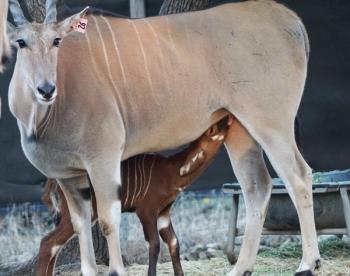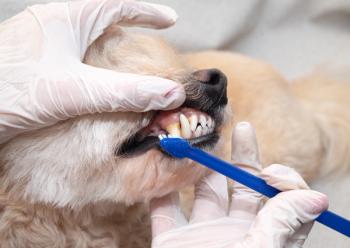
Protein-losing nephropathy (Proceedings)
The kidneys are the only organ system within the body containing two sets of capillary beds with different functions. The glomerulus consists of 4-8 lobules containing glomerular capillaries with mesangium providing structural support to hold the capillaries together.
The normal glomerulus
The kidneys are the only organ system within the body containing two sets of capillary beds with different functions. The glomerulus consists of 4-8 lobules containing glomerular capillaries with mesangium providing structural support to hold the capillaries together. Blood travels into the glomerulus via the afferent arteriole, and exits via the efferent arteriole to travel into renal capillaries. The structure of the glomerular capillaries consists of vascular endothelium covering basement membrane. The basement membrane is covered by epithelial cells which form foot processes (podocytes). The glomerular capillary bed is approximately 500 times more “leaky” than other capillary beds in the body, which causes ideal suitability for the primary function of filtration.
Filtration occurs due to the driving force of hydrostatic pressure across the glomerulus, and the particles that filter are determined both by their size and charge. The pore size for filtration is approximately 69,000 Daltons, which is approximately the size of albumin. The basement membrane and surrounding structures makes negatively charged glycoproteins, which repels negatively charged particles like albumin. With this structure, small molecules like urea, creatinine, electrolytes, amino acids, glucose, and other metabolic products and hormones filter freely, whereas albumin, larger plasma proteins, and coagulation factors are retained.
Types of glomerular damage
When conditions change at the level of the glomerulus that allows protein loss into the urine, a patient is identified as having a protein-losing nephropathy (PLN). There are a variety of structural changes that cause PLN. In human medicine, PLN is quite accurately identified since renal biopsy is performed routinely as part of the diagnostic workup, and glomerular injury is defined to the ultrastructural level with electron microscopy (EM) employed to enhance diagnosis made with light microscopy. In dogs and cats with PLN biopsy and histopathology are less commonly performed, and EM to further characterize the disease process is not widely available.
Common classifications of PLN in animals consist of glomerulonephritis, amyloidosis, and familial glomerulopathy. Breeds associated with familial glomerular disease are shown in Table 1. Glomerulonephritis (GN) refers to particular glomerular diseases in which an immune-mediated process causes glomerular injury. These changes are typically associated with a type III (antigen- antibody – complement) immune reaction.
The vast majority of GN is acquired, in which antigen-antibody complexes form in circulation (most commonly), or in situ (as with heartworm disease), and activate complement. Cell-mediated immunity participates in inflammation, and complement activation causes recruitment of neutrophils, macrophages, platelets, proteolytic enzymes, cytokines, and pro-inflammatory mediators to perpetuate injury. With the circulating antigen-antibody initiated disease, the antigen and antibody must be present in relatively similar quantities in circulation. Excess of antibody creates larger complexes that are removed by the reticuloendothelial system, and an excess of antigen not bound to antibody will filter freely at the glomerulus. Common etiologies are listed in Table 2.
Amyloidosis is less common than glomerulonephritis as a cause of PLN, with the exception of familial amyloidosis in Shar Pei dogs and Abyssinian cats. In non- familial amyloidosis, females are slightly predisposed. Amyloid A protein is manufactured by hepatocytes stimulated by cytokines interleukin 1 and 6, and tumor necrosis factor, as an acute-phase reactant in response to inflammation. When amyloid A protein is deposited in tissues, the structure is formed into a beta-pleated sheet configuration which is insoluble. Causes for deposition in a given individual are multifactorial. Specific causes identified as causing amyloidosis are included in Table 3.
Clinical presentation of protein losing nephropathy
The clinical picture of PLN varies from clinically silent to vague signs to overt renal failure. Early diagnosis is crucial since the only time to make an impact with treatment is initiating treatment prior to onset of kidney failure. Kidney failure is always the end stage of PLN that does not have a specific, curable underlying cause. The onset of kidney failure can be rapid or insidious. For example, in PLN secondary to Borrelia bergdorferi infection (Lyme disease) which presents in middle-aged Labrador and Golden retrievers, the time between initial diagnosis of PLN and death from renal failure is typically quite short (1-2 months).
On the other hand, dogs with other causes of PLN can live for months to years between the time of diagnosis of PLN and ultimate death from kidney disease, and seem to be more responsive to medical management. If an underlying cause is diagnosed that can then be cured (e.g. heartworm disease, hyperadrenocorticism), the progression of PLN to kidney failure might be halted. There is mounting evidence in human medical literature that chronic exposure of the renal tubular epithelium to the protein escaping from the glomerulus is harmful. The protein causes local injury that stimulates an inflammatory response, and ultimately causes tubular death and nephron loss. In addition, as glomerular injury progresses to glomerulosclerosis, nephron loss occurs. Adequate control of protein loss with medical therapy is likely to slow progression of nephron injury and death from tubular loss.
Certain body systems can have detrimental changes secondary to PLN. Common complications include hypertension, hypercoagulability, and hyperlipidemia. Hypertension has been reported win up to 80% of dogs with PLN. In people, the risk of hypertension secondary to PLN varies with the histopathologic classification of disease. The pathogenesis of hypertension is not entirely clear, but probably results from sodium retention causing increased vascular volume, and increase of vasoactive substances causing hypertension. Target organ systems that can become injured with hypertension include the eyes, heart, central nervous system, and kidneys. With exception of the kidneys, injury to the other organ systems typically present as a rapid deterioration, as is the case with retinal detachment or cerebral vascular accident.
Hypercoagulability results from loss of anticoagulant factors in excess of procoagulant factors. The coagulation system is a delicate balance of pro- and anticoagulant factors which allow rapid clot formation in times of need, with resistance to clot formation spontaneously. The anticoagulant factor Antithrombin (AT, formerly Antithrombin III) is of similar size to albumin, and is therefore lost through enlarged glomerular pores. The procoagulant factors are larger than AT and are therefore retained, resulting in an excess of procoagulant factors and hypercoagulability. Thrombi can form spontaneously, and PLN is a recognized risk factor for development of pulmonary thromboembolism.
Hypercholesterolemia is a common finding in dogs with PLN, and people with PLN have elevations in very-low-density lipoproteins and low-density lipoproteins. Development of hyperlipidemia is seen in people with PLN, but has not yet been commonly recognized in dogs. Hypercholesterolemia develops with hypoalbuminemia since metabolic pathways to make cholesterol are stimulated when hepatic albumin synthesis increases.
Diagnosis of glomerular disease
The best way to achieve early diagnosis of PLN is to maintain an index of suspicion, and to monitor urinalysis as frequently as complete blood count and serum biochemical analysis are evaluated in practice. Complete blood count changes with PLN are nonspecific; however might provide clues to an underlying etiology for PLN. Serum biochemical analysis changes most commonly include hypercholesterolemia hypoalbuminemia, azotemia, and hyperphosphatemia. Of these changes, hypercholesterolemia usually precedes the other changes, and this biochemical finding should lead the clinician to investigate urine for proteinuria of urinalysis has not yet been performed.
Urinalysis reliably shows evidence of proteinuria with PLN. The greater the urine concentration, the more likely protein will show up on the urine dipstick. The dipstick test for protein is a good place to start; however is not as accurate as some other methods of protein identification and is not a quantitative test. Urine can contain protein from glomerular protein leak, acute tubular injury, and lower urinary tract inflammation. Therefore, complete urinalysis with microscopic evaluation of urine sediment is always indicated to further characterize protein loss. Special attention should be given to the sediment evaluation to look for red or white blood cells, bacteria, or granular casts. Some laboratories perform protein evaluation with sulfosalicylic acid (SSA) which is a more accurate method than urine dipstick to identify proteinuria. An SSA level of greater than 30 mg/dl is confirmatory of proteinuria. Protein losing nephropathy is by definition a chronic disease process, and identification of urine protein on a single urine sample is not sufficient to diagnose PLN since other disease processes can cause proteinuria. Performing paired urine evaluations 3 to 4 weeks apart is needed to confirm diagnosis of PLN prior to initiating therapy.
Urine protein: creatinine ratio (UP:UC) is the method commonly employed to quantify protein loss, and to monitor response to therapy over time. This test compares the amount of protein lost in any single urine sample to the amount of creatinine lost. In any given individual, the amount of creatinine produced and lost should be relatively consistent over time providing the animal is normally hydrated and has not experienced severe muscle injury. Urinalysis should always be performed on the same urine sample used to evaluate UP:UC since inflammation in the sediment will increase urinary protein from non-glomerular sources.
The protein and creatinine are measured on chemistry analyzers in commercial laboratories; however in-house chemistry machines have proven to be inaccurate to measure urine creatinine. A UP:UC of >0.5 is abnormal in dogs and cats. Measurements of 0.5 to 1.0 are considered a “grey zone” for excessive proteinuria, and measurements of >1.0 are always considered abnormal. Historically, correlations between absolute value of UP:UC and histopathologic diagnosis have tried to be drawn, with extreme elevations of UP:UC being considered more consistent with amyloidosis; however this method is not accurate and biopsy and histopathology are still needed for diagnosis. The only other method to quantify urine protein loss involves 24-hour urine protein quantification. Twenty-four hour urine collection is problematic for veterinary practitioners and pet owners.
General treatments for protein losing nephropathy
Once proteinuria has been confirmed by repeat testing over time, specific therapies to reduce proteinuria are indicated. The drugs most commonly employed to reduce glomerular protein loss are angiotensin converting enzyme (ACE) inhibitors, with enalapril being utilized most often. Enalapril reduces protein loss by preventing efferent arteriolar constriction and reducing intraglomerular pressure. This treatment has been shown to improve survival and outcome in dogs with PLN regardless of the underlying cause. By the same mechanism that reduces proteinuria, enalapril can reduce intraglomerular pressure to the point of detrimental reduction of GFR in hypovolemic animals. Therefore, it is imperative to insure euvolemia prior to initiating therapy, and counsel the owner to always maintain access to fresh water for their pet and to recognize sources of potential hypovolemia like vomiting or diarrhea. Serum biochemical profile should be reevaluated 1 week after initiating therapy or dose increase to evaluate for azotemia. The dose of enalapril to start with is 0.5 mg/kg daily. This dose can be increased to 1 mg/kg twice daily if needed.
Dietary adjustments can also be made to reduce protein loss. Intuitively, one might assume that increased dietary protein would be beneficial with ongoing protein loss; however dietary protein can increase urinary protein which can have detrimental renal effects. Dietary protein restriction, with provision of highly bioavailable protein sources, is warranted. Low protein renal-type prescription diets are reasonable choices. Blood pressure should be monitored at each follow-up visit in animals with PLN. Since ACE inhibitors have combined antihypertensive and anti-proteinuric effects and will be instituted at the time of diagnosis, blood pressure can be monitored to evaluate response to this therapy alone.
If hypertension persists despite therapy with ACE inhibitors and dose escalation is contraindicated, other agents can be added. The most common antihypertensive therapy is amlodipine, a vascular-specific calcium channel blocker. Amlodipine dose typically starts at 0.0625-0.125 mg/kg daily, and can be gradually increased while monitoring blood pressure weekly to every other week. Since blood pressure in animals can be falsely elevated in stressful situations such as the veterinary hospital. The client should be instructed to evaluate for signs of hypotension at home. These signs include lethargy, weakness, and poor responsiveness to the owner.
There is no good way to determine hypercoagulability in the clinical setting. Since AT is lost by the same mechanism as albumin, patients that are hypoalbuminemic can be presumed to have lost AT. Clinically, PLN has been associated with thromboembolic disease, therefore thromboprophylaxis is commonly initiated at the time of diagnosis of PLN. Heparin is not appropriate as an anticoagulant since it's major anticoagulant activity is achieved by increasing AT activity, and AT deficiency is causing the hypercoagulability in PLN. Acetylsalicylic acid (Aspirin) is the anticoagulant of choice. A dose of 0.5-1 mg/kg q 24 hours will inhibit platelet aggregation with decreased risk of side effects (e.g. gastrointestinal ulceration) seen at standard doses.
Specific therapies for glomerulonephritis or amyloidosis
Immunosuppressive therapy has been advocated for treatment of GN. The only controlled clinical trial involved cyclosporine in dogs and was of no benefit. Immunosuppressive corticosteroids do not appear helpful in most cases of canine GN, but are beneficial in cats. Other immunosuppressive drugs (like azothioprine) are indicated if active inflammation is seen on renal biopsy.
Since amyloid protein is insoluble, treatments to reduce amyloid deposits may not be helpful. The most common treatment recommendation for amyloidosis is dimethylsulfoxide (DMSO). Proposed beneficial mechanisms for this therapy include reduction of amyloid deposits, and reduction of the inflammatory response. There are a variety of dosing regimens published, with the most common being 90 mg/kg given by mouth three times a week. Chemical grade DMSO should be diluted 1:4 with water prior to administration. The unpleasant odor of DMSO may lead to poor owner compliance with this treatment. With amyloidosis that occurs as a late onset of Shar Pei Fever, colchicine is sometimes recommended at the time of initial diagnosis of the recurrent fever phase of the disease. Colchicine will not resolve pre-existing amyloid deposits. The dose of colchicines is 0.01 to 0.03 mg/kg orally once a day. Gastrointestinal upset is the most common side effect.
Treatment of renal failure caused by protein losing nephropathy
Once renal failure has developed, most standard therapies for renal failure are appropriate, with a few caveats about fluid therapy. In the hospitalized patient, substituting a colloidal fluid (Hetastarch, Dextran) for all or part of the crystalloid fluid requirement may decrease development of peripheral edema.
Prognosis varies with the underlying cause of PLN. Amyloidosis generally carries a poor prognosis for long-term survival or response to therapy, although individual cases have been reported in the literature that have responded more favorably to DMSO. With GN, if an underlying disease can be identified and resolved prior to the onset of renal failure, prognosis can be guarded to good for long-term survival. If renal failure is already established at the time of diagnosis of PLN, long term prognosis is poor.
Table 1: Breeds Identified with Familial Glomerular Diseases
Glomerulonephritis Bernese mountain dog, Bull terrier, English cocker spaniel, Dalmatian, Doberman pinscher, Greyhound, Newfoundland, Rottweiler, Soft-coated wheaten terrier Amyloidosis
Dogs: Beagle, English foxhound, Shar Pei
Cats:
Abyssinian
Table 2: Diseases Associated with Glomerulonephritis in Dogs and Cats
Bacterial Borreliosis, Bartonellosis, Brucellosis, Endocarditis, Pyometra, Pyoderma, Pyelonephritis, Mycoplasmal polyarthritis, Other chronic infections Protozoal Babesiosis, Hepatozoonosis, Leishmaniasis, Trypanosomiasis Rickettsial Ehrlichiosis Viral Canine adenovirus type 1, Feline immunodeficiency virus, Feline infectious peritonitis, Feline leukemia virus Parasitic Dirofilariasis Fungal Coccidiomycosis Inflammatory Chronic dermatitis, Inflammatory bowel disease, Pancreatitis, Periodontal disease, Polyarthritis, Systemic lupus erythematosus, Cholangiohepatitis, Chronic progressive polyarthritis, Other immune-mediated diseases Neoplastic Leukemia, Lymphoma, Mastocytosis, Systemic histiocytosis, Other neoplasms Miscellaneous Corticosteroid excess, Trimethoprim-sulfa drug therapy, Congenital C3 deficiency, Acromegaly, Mercury toxicity Idiopathic
Table 3: Diseases Associated with Amyloidosis in Dogs and Cats
Bacterial Pyelonephritis, Pyoderma, Pyometra, Other chronic bacterial infections Protozoal Leishmaniasis Parasitic Dirofilariasis Fungal Coccidiomycosis, Blastomycosis Inflammatory Chronic dermatitis, Pancreatitis, Periodontal disease, Polyarthritis, Systemic lupus erythematosus Neoplastic Lymphoma, Other neoplasms Miscellaneous Chronic insulin infusion Idiopathic
Newsletter
From exam room tips to practice management insights, get trusted veterinary news delivered straight to your inbox—subscribe to dvm360.






